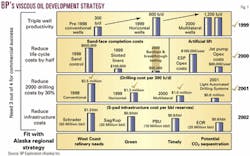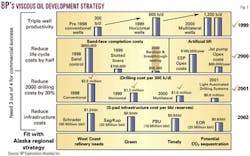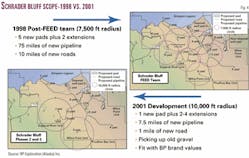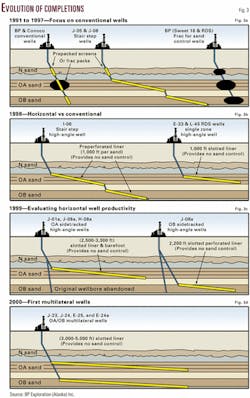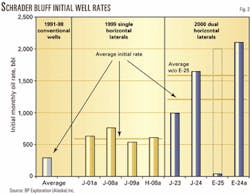This article is a late-breaking adjunct to the special report that begins on p. 58.
More than 3 decades after its discovery, Alaskan North Slope operators are beginning to unlock the huge commercial potential of the slope's viscous heavy oil resource.
As much as 21-36 billion bbl of OOIP has been estimated for the areally vast West Sak and Ugnu formations that overlie the main producing hor- izons in the Ku- paruk River and Milne Point field areas west of Prudhoe Bay. At average depths of 3,000 ft and 3,500 ft, respectively, their proximity to the permafrost renders the already low-gravity crudes extremely viscous.
Coupled with the fact that the formations feature highly friable, weakly consolidated or unconsolidated sands, the slope's viscous crudes have proven virtually intractable to produce economically with conventional technology. And, until recently, the wells drilled to date in the West Sak reservoir-chosen first because its crudes have gravities of 14-24° vs. 10-14° for Ugnu-had not been sufficiently productive to warrant their high costs.
But BP Exploration (Alaska) Inc. and Phillips Alaska Inc.-and ARCO Alaska Inc. before its acquisition by BP and subsequent sale to Phillips-have relentlessly chipped away at the barriers to commercial development of North Slope viscous crudes. Advances in drilling and production technology have enabled the companies to gradually change the cost structure of developing the slope's viscous crudes. The results of these innovations are sharply reduced operating and maintenance costs, increased well productivity, and another extension of the prevailing philosophy among ANS operators to minimize the footprint of their operations on the slope.
Phillips is operator of West Sak field in the greater Kuparuk area, while BP operates the extension of the same formation, called Schrader Bluff, in the Milne Point field area.
Current estimates put West Sak OOIP at 12-13 billion bbl; the core, 60,000 acre development area holds about 3 billion of OOIP. Schrader Bluff covers more than 32,000 acres and is thought to hold more than 2 billion bbl of OOIP. Gravities at the deeper-pay Schrader Bluff are a bit lighter, about 18-22°.
While BP is 100% owner of Schrader Bluff, it also holds a 39.3% interest in West Sak together with Phillips 55.3%, Unocal Corp. 4.9%, Exxon- Mobil Corp. 0.4%, and Chevron Corp. 0.1%. Accordingly, the two operators share information on how each is developing its portion of the viscous resource. Their approach essentially is to undertake development incrementally, developing the "sweet spots" first, then using what they've learned to tweak the proven technology a bit more to further trim costs or bolster well productivity. And BP and Phillips continue to study other new technologies to introduce in their development of the North Slope viscous crudes.
Currently, the target for recovery is about 22%. Achieving even that much just at Schrader Bluff would be roughly the equivalent of discovering another Alpine oil field, BP said. Extending that to the conservative end of estimates for the entire North Slope viscous crude resource would then yield the equivalent of another Kuparuk River field-the second-largest US oil field.
History
Discovered by ARCO in 1969, West Sak's formidable technical and economic challenges left the vast resource un- touched for years as the two principal North Slope operators at the time, BP and ARCO, tackled much more pliable developments on the slope.
But the then-impending decline at supergiant Prudhoe Bay field revived interest in the huge viscous crude resource on the slope.
After implementing a pilot project at West Sak in the mid-1980s, ARCO concluded that recovery costs were too high to make development commercially viable. But a decade later, that view changed with the march of advancing technology. ARCO set in motion Phase 1 of a commercial West Sak development that was programmed to start production by yearend 1997. It envisioned 50 wells would be drilled from two existing drillpads with a 2:1 split between producers and water injectors. The 50 Phase I wells were to be completed by sometime in 1999 and would add another 51 million bbl of reserves and 7,000 b/d to North Slope production by 1999. ARCO and BP earmarked $92 million for the project, in which costs were to be held down by making extensive use of existing Kuparuk drillsites, pipelines, and processing facilities.
Long-range plans at the time called for drilling 550 wells at West Sak to develop 400 million bbl of reserves and yield output of 37,000 b/d by 2001 and 70,000 b/d by 2005.
ARCO started commercial production from the first West Sak well on Dec. 26, 1997. However, the industry downturn of 1998-99 intervened, and ARCO halted West Sak development.
Since then, BP and Phillips-inheritor of ARCO's assets-have marked major strides in resolving the problems encountered with producing North Slope viscous crudes. In the process, they have found new ways to slice lifting costs in half and to more than triple well productivity.
David Jenkins, BP Alaska's viscous oil team leader, recounted the progress both companies have made in exploiting the North Slope's viscous crudes in an interview with OGJ.
Changing plans
Jenkins described the initial approach to developing West Sak as "carpet drilling," in which the operator would drill "lots of very cheap wells in order to get the resource out. And the reason for that type of oil technology is that we are talking about thin sand layers, so...the goal has always been to kind of add up as many sand packages as possible."
But such density of development would require bringing the volume of reserves recovered per well to a level that would make economic sense, Jenkins noted.
"So what really people have been after for even the last 10 years is how to get the well productivity up," he said. "At the same time...we also have the related challenges in that we're working in very weakly consolidated, all the way down to unconsolidated sands. And that typically requires placing special completion equipment, which increases the cost.
"Not only does the sand control equipment increase the cost of the well, it actually further reduces well productivity-provides a barrier to flow."
That realization led to efforts to develop sand control techniques that also allowed the opportunity to provide some sort of stimulation to offset production losses. And BP arrived at a "frac-and-pack" approach that entailed hydraulically fracturing the rock, propping it open with gravel, and adding screens behind it.
"We had some success with that in the Gulf of Mexico with unconsolidated sand, but we were probably less successful here in reducing the damage," Jenkins said. "We moved on from that to something that for a while looked pretty promising that was called 'frac-percent control.'"
With this approach, BP used an artificial, coarse-grain gravel as a proppant with a resin coating that essentially glued all the proppant grains together to hold sand back.
However, the shallow reservoir's low temperatures (75-80° F.) caused the resin coatings and the gel fluids used to create fractures to persist rather than decompose as they do in deeper, hotter reservoirs, making it difficult to clean up the fractures.
BP then found itself coping with producing sand and back-producing proppant, which was killing the electric submersible pumps used in artificial lift at Schrader Bluff. Apart from increasing costs, this hurdle kept output to a subeconomic average 300 b/d/well.
Horizontal wells
By the end of 1997, BP began to consider long horizontal wells with no sand control, after conducting some field trials with long horizontal wells with sand controls, an effort met with mixed results.
The company's petroleum engineering team then attempted what Jenkins called "a very gutsy move."
"A guy named Jim Spearman convinced the management team to basically drill this long horizontal well, actually stair-stepped it through the two major sands...and he put in a length of pipe to hold the sand open...Whereas, normally, he would have run the screens, what he ran instead was a piece of pipe, basically a 1-in. pole...all the way along the wellbore...providing no sand control protection at all. And that well turned into the best well in 1997. At the same time, we drilled 15 or 16 of these frac-sand control wells, and they were all not performing. We drilled this well, and it was performing at more than twice the rate of these other wells."
That well came in at about 800 b/d and, despite initial fears about sand collapse, is still producing today. This success led to efforts to test other wells without sand control and trying slotted liners rather than a preperforated pipe.
"What we learned out of the first three of those [wells] is that even in these very weak formations, these types of completions-while not providing barriers to flow-would do enough of a job at holding the sand back that it was unlocking...the well potential."
ERD multilaterals
The BP viscous crude engineering team at yearend 1998 proposed a long horizontal multilateral well development project test at Milne Point before moving to full development.
"We've spent the last 3 years...progressing the technology from single-lateral long horizontal wells into multilateral long horizontal wells. And what we've done is we've basically tripled and in some cases even quadrupled the initial production rates."
In 1999, in a bid to further prove the technology and thus unlock full development, BP developed a four-pronged strategy (Fig. 1), Jenkins said: "We wanted to triple our productivity, we wanted to reduce life-cycle costs by half, we wanted to reduce the drilling cost by 30%, and we also wanted to reduce infrastructure costs."
Moving to the long multilateral wells presented major savings for the two operators while boosting productivity (Fig. 2).
A conventional well tapping the thin pay sands at West Sak and Schrader Bluff typically would cost $2.5 million for a flow rate of 300 b/d. In 1999, BP drilled four single-lateral wells at $2.6 million apiece, reducing the cost per 300 b/d to $1.3 million. Now a $4 million multilateral well producing 1,200 b/d brings the cost per 300 b/d to $1.0-1.1 million (Fig. 3).
The next step in reining drilling costs is the Light Automated Drilling System, developed by a consortium of service companies, which has the goal of reducing the cost of drilling a slope well by up to 30%. It will be designed to have a third of the footprint and half the crew of a conventional rig mainly through integrating automated equipment for pumping and cementing normally provided manually by a third party onto the rig. The first LADS rig is under construction and is to be delivered to the slope in January 2002.
The switch to extended-reach drilling dramatically changed the footprint of the proposed viscous oil development. A conventional-well approach-which have limited BP to a radius of about 7,500 ft from the drillpad-to developing Schrader Bluff would have called for adding five new pads, 75 miles of new pipeline, and 10 miles of new road.
BP sought to press the limits of shallow ERD and found that, by pushing the drilling radius well beyond 10,000 ft, it could now envision a development scheme involving one pad, 7.5 miles of pipeline, and 1 mile of road (Fig. 4). That drastically cuts back the footprint and the number of projected Schrader Bluff wells to 150-200 from about 500.
That leaves the next step at Schrader Bluff as what Jenkins calls a "focused project," S Pad development, which was to be sanctioned last month and entails 14 oil producers and 20 water injectors. Drilling is to get under way next year. The recovery target for the $175 million project is 62 million bbl, and incremental production is expected to peak at 15,000 b/d in 2003.
The S Pad development is on the western periphery of the original Tract 14 area that predecessor Conoco Inc. (which sold its Milne Point interests to BP in 1994) developed. Meantime, BP is also working its way into the downdip area, closer to the oil-water contact and thus making the crude even more viscous, on the northern periphery of Tract 14. After the S Pad project, BP plans to redevelop the core Tract 14 area, employing multilateral wells drilled with coiled tubing (Fig. 5).
"So with S Pad and redevelopment of the tract 14 area and picking up the peripheral bits that we know are really good, that's really taking us into a focused development effort through 2005, at least," Jenkins said. "And we're already beginning to open up the technology of what moved us into the downdip area. So we're really looking at kind of a focused development effort that should take us all the way out through about 2010."
Differing approaches
While they share information, Phillips and BP have taken different approaches in some areas, although the two companies hope to merge their thinking on viscous crude development within the next 12-18 months, Jenkins noted.
"The key difference there is in risk," he said. "We really took a stepout-we actually even tried a barefoot well candidate where we didn't support it with anything. So...BP has gone right to the edge of...what the minimum requirement is to make a successful well. And we've been doing a lot of testing about how robust these wells will be, and the big unknown has been when the water breaks through from the injector to the producer."
The prevailing thinking is that, when that breakthrough occurs, sanding tendencies go up.
"We're already starting in a weakly consolidated area, so even though we've proven success at producing those wells under primary depletion conditions, the whole unknown is what happens when the waterflood gets through. And BP has been doing some specific testing in the field to prove to ourselves that these wells will be robust even under those conditions. And we're at the point now where we think we've basically shown that that's true...we have actually gone out and initiated a trial where we took a nearby injector to one of our long horizontal slotted liner producers and we flooded it out. And we observed no increase in sanding tendencies.
"Now Phillips, on the other hand, has taken the stance that...when the risk is high enough that when the waterflood breaks through, you'll need to go fix these wells. It's cheaper to install sand control equipment now rather than try to fix them later. So they started from a development where their first three multilateral wells had full sand control equipment.
"Now, we've drilled 6-9 multilateral wells, and we've put slotted-liner completions in them all. And the prize is significant. If we're saying that the average well cost is on the order of $4 million to drill a slotted-liner multilateral well, it's more in the order of $5.5 million to add sand control. So it's...a $1.5 million/well prize to be able to prove that you don't have to do that. That's a prize that we're both interested in, and we're just approaching it from different perspectives."
Jenkins sees value in the differing approaches, considering that Schrader Bluff has some shallower horizons on the development outlook that will require sand control, so BP will be able to benefit from the knowledge Phillips gains in that area.
Artificial lift
Having surmounted the challenges of drilling reach, well productivity, and sand control, BP began to look at changing its approach to artificial lift.
Most of the BP and Phillips viscous oil wells have been produced using either ESPs or electric submersible progressive cavity pumps. While Phillips is looking into the prospects for retrievable-ESP technology at West Sak, BP is considering switching to jet pumps from ESPs Jet pumps don't require a large rig for change-out when they fail, as do ESPs.
Problems with excessive sanding can wear out ESPs pretty quickly-causing about a 2-3 year run life. And at Schrader Bluff, that means changing out a third to half of the ESPs each year at a cost of $300,000 each. As well rates decline, such costs become prohibitive, and wells are shut in while there is still a lot of oil behind pipe.
"The great thing about jet pumps is, No. 1, they're very sand-tolerant. So if we do get ourselves into place with these slotted-liner completions producing more sand, we can handle it. And, secondly, you can run these in and out of the well with slickline. So whereas it costs an average of $300,000 every couple of years to replace an ESP, it costs something like $10,000 maybe once a year to replace a [jet pump] nozzle."
That situation is ideal for viscous crude, because such wells tend to recover oil at a lower rate but over a longer lifespan than do other wells.
Phillips currently is undertaking an artificial lift review for its next major viscous oil development, says Jenkins, which is about 2.5 times the size of the S Pad project.
"They're now finalizing their design, and it's going to be somewhere between wireline-retrievable ESPs and/or jet pumps," he said. "And they're keenly looking at what we're doing with jet pumps and what we're currently improving in the field to make that final determination, so that's another area that we're sharing."
In the longer term, says Jenkins, the two companies will be conducting tests and field trials of other technologies to exploit the viscous crude resource on the North Slope, including pressure-pulse technology, cold production, and miscible-enriched gas injection that could incorporate CO2 and produced NGL.
The recent success the two slope operators have had with bodes well for developing the West Sak formation outside the 3 billion bbl core area and Schrader Bluff and perhaps ultimately the lower-gravity Ugnu.
"[The program] is all about identifying technology to walk our way down the API gravity curve," Jenkins said. "So we would be looking at developing this whole resource in tranches...and where we've got to now is that it looks like we're in the place where the kind of 16-21 API gravity stuff is what were unlocking...And then beyond the next, say, 5 years...the commitment to a long-term future is going to be about how we unlock those even heavier-gravity oils."
